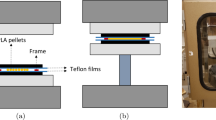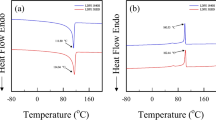Abstract
This work proposes a qualitative analysis of the particle-induced viscosity reduction phenomenon observed in polymeric composites like polylactic acid (PLA)/partially methylated silica particles, but not in composites like PLA/hydroxyl-terminated silica particles. The analysis is mainly based on considerations of the friction coefficients of spherical particles in the composites. The analysis reveals that sufficiently small particles, relatively weak polymer–particle interfacial interactions, particle rotation, and the existence of interfacial slipping in a polymeric composite are necessary conditions for the occurrence of particle-induced viscosity reduction, while long-distance particle–particle interactions based on polymer–particle interactions, and possibly existing additional interfacial elastic behaviors conversely lead to an increase in viscosity. The ratio of the radius of the particles to the gyration radius of the coils of polymer chains in polymer melts (R/R g) is found to be not crucial.












Similar content being viewed by others
References
Münstedt H, Köppl T, Triebel C (2010) Viscous and elastic properties of poly(methyl methacrylate) melts filled with silica nanoparticles. Polymer 50:185–191
Romeo G, Filippone G, Russo P, Acierno D (2009) Effects of particle dimension and matrix viscosity on the colloidal aggregation in weakly interacting polymer-nanoparticle composites: a linear viscoelastic analysis. Polym Bull 63:883–895
McEwan M, Green D (2009) Rheological impacts of particle softness on wetted polymer-grafted silica nanoparticles in polymer melts. Soft Matter 5:1705–1716
Ye L, Xie Y, Qiu D, Kan Y, Zhang Z (2014) Particle shape dependence of rheological behavior for colloid-polymer mixtures. Chin J Polym Sci 32:1515–1523
Wang D, Yang M, Dong Z, Bo S, Ji X (2013) Interaction between poly (ethylene oxide) and silica nanoparticles in dilute solutions. Chin J Polym Sci 31:1290–1298
Song Y, Zheng Q (2015) Linear rheology of nanofilled polymers. J Rheol 59:155–191
Atilgan C, Inanc I, Atilgan AR (2012) On modifying properties of polymeric melts by nanoscopic particles. J Polym Sci Part B 50:1653–1662
Kumar SK, Jouault N (2013) Nanocomposites with polymer grafted nanoparticles. Macromolecules 46:3199–3214
Moll JF, Akcora P, Rungta A, Gong S, Colby RH, Benicewicz BC, Kumar SK (2011) Mechanical reinforcement in polymer melts filled with polymer grafted nanoparticles. Macromolecules 44:7473–7477
Baeza GP, Genix AC, Degrandcourt C, Petitjean L, Gummel J, Schweins R, Couty M, Oberdisse J (2013) Effect of grafting on rheology and structure of a simplified industrial nanocomposite silica/SBR. Macromolecules 46:6621–6633
Mackay ME, Dao TT, Tuteja A, Ho DL, Horn B, Kim H, Hawker CJ (2003) Nanoscale effects leading to non-einstein-like decrease in viscosity. Nat Mater 2:762–766
Gordon GV, Schmidt RG, Quintero M, Benton NJ, Cosgrove T, Krukonis VJ, Williams K, Wetmore PM (2010) Impact of polymer molecular weight on the dynamics of poly(dimethylsiloxane)-polysilicate nanocomposites. Macromolecules 43:10132–10142
Schmidt RG, Gordon GV, Dreiss CA, Cosgrove T, Krukonis VJ, Williams K, Wetmore PM (2010) A critical size ratio for viscosity reduction in poly(dimethylsiloxane)-polysilicate nanocomposites. Macromolecules 43:10143–10151
Tuteja A, Mackay ME, Hawker CJ, Horn BV (2005) Effect of ideal, organic nanoparticles on the flow properties of linear polymers: non-Einstein-like behavior. Macromolecules 38:8000–8011
Kopesky ET, Haddad TS, Cohen RE, McKinley GH (2004) Thermomechanical properties of poly(methyl methacrylate)s containing tethered and untethered polyhedral oligomeric silsesquioxanes. Macromolecules 37:8992–9004
Jain S, Goossens JGP, Peters GWM, Duin M, Lemstra PJ (2008) Strong decrease in viscosity of nanoparticle-filled polymer melts through selective adsorption. Soft Matter 4:1848–1854
Nusser K, Schneider GJ, Pyckhout-Hintzen W, Richter D (2011) Viscosity decrease and reinforcement in polymersilsesquioxane composites. Macromolecules 44:7820–7830
Tan H, Zheng J, Xu D, Wan D, Qiu J, Tang T (2014) Dependence of melt behavior of star polystyrene/POSS composites on the molecular weight of arm chains. J Phys Chem B 118:5229–5239
Tuteja A, Duxbury PM, Mackay ME (2007) Multifunctional nanocomposites with reduced viscosity. Macromolecules 40:9427–9434
Wu J, Haddad TS, Kim GM, Mather PT (2007) Rheological behavior of entangled polystyrene-polyhedral oligosilsesquioxane (POSS) copolymers. Macromolecules 40:544–554
Fu BX, Gelfer MY, Hsiao BS, Phillips S, Viers B, Blanski R, Ruth P (2003) Physical gelation in ethylene-propylene copolymer melts induced by polyhedral oligomeric silsesquioxane (POSS) molecules. Polymer 44:1499–1506
Madbouly SA, Otaigbe JU, Nanda AK, Wicks DA (2007) Rheological behavior of poss/polyurethane-urea nanocomposite films prepared by homogeneous solution polymerization in aqueous dispersions. Macromolecules 40:4982–4991
Kamibayashi M, Ogura H, Otsubo Y (2006) Rheological behavior of suspensions of silica nanoparticles in associating polymer solutions. Ind Eng Chem Res 45(21):6899–6905
Yang S, Yan D (2006) Structure of adsorbed polymers on a colloid particle. Macromolecules 39:4168–4174
Meins JFL, Moldenaers P, Mewis J (2002) Suspensions in polymer melts. 1. Effect of particle size on the shear flow behavior. Ind Eng Chem Res 41:6297–6304
Kropka JM, Putz KW, Pryamitsyn V, Ganesan V, Green PF (2007) Origin of dynamical properties in PMMA-C60 nanocomposites. Macromolecules 40:5424–5432
Senses E, Akcora P (2013) An interface-driven stiffening mechanism in polymer nanocomposites. Macromolecules 46:1868–1874
Yang J, Han CR, Duan JF, Xu F, Sun RC (2013) Interaction of silica nanoparticle/polymer nanocomposite cluster network structure: revisiting the reinforcement mechanism. J Phys Chem C 117:8223–8230
Yang J, Han CR (2013) Dynamics of silica-nanoparticle-filled hybrid hydrogels: nonlinear viscoelastic behavior and chain entanglement network. J Phys Chem C 117:20236–20243
Smith GD, Bedrov D, Li L, Byutner O (2002) A molecular dynamics simulation study of the viscoelastic properties of polymer nanocomposites. J Chem Phys 117:9478–9489
Sen S, Thomin JD, Kumar SK, Keblinski P (2007) Molecular underpinnings of the mechanical reinforcement in polymer nanocomposites. Macromolecules 40:4059–4067
Patti A (2014) Molecular dynamics of spherical nanoparticles in dense polymer melts. J Phys Chem B 118:3731–3742
Liu J, Cao D, Zhang L (2008) Molecular dynamics study on nanoparticle diffusion in polymer melts: a test of the Stokes-Einstein law. J Phys Chem C 112:6653–6661
Ganesan V, Ellison CJ, Pryamitsyn V (2010) Mean-field models of structure and dispersion of polymer-nanoparticle mixtures. Soft Matter 6:4010–4025
Mackay ME, Tuteja A, Duxbury PM, Hawker CJ, Van Horn B, Guan Z, Chen G, Krishnan RS (2006) General strategies for nanoparticle dispersion. Science 311:1740–1743
Nielsen LE, Landel RF (1994) Mechanical properties of polymers and composites, 2nd edn. Marcel Dekker, New York
Cumberland DJ, Crawford RJ (1987) The packing of particles, handbook of powder technology, vol 6. Elsevier, Amsterdam
Wu X, Zhao H, Nörnberg B, Theato P, Luinstra GA (2014) Synthesis and characterization of hydroxyl-functionalized poly(propylene carbonate). Macromolecules 47:492–497
Li Y, Shimizu H (2009) Compatibilization by homopolymer: significant improvements in the modulus and tensile strength of PPC/PMMA blends by the addition of a small amount of PVAc. ACS Appl Mater Interfaces 1:1650–1655
Wang D, Yu J, Zhang J, He J, Zhang J (2013) Transparent bionanocomposites with improved properties from poly(propylene carbonate) (PPC) and cellulose nanowhiskers (CNWs). Compos Sci Technol 85:83–89
Yang G, Geng C, Su J, Yao W, Zhang Q, Fu Q (2013) Property reinforcement of poly(propylene carbonate) by simultaneous incorporation of poly(lactic acid) and multiwalled carbon nanotubes. Polym Degrad Stabil 87:196–203
An J, Ke Y, Cao X, Ma Y, Wang F (2014) A novel method to improve the thermal stability of poly(propylene carbonate). Polym Chem 5:4245–4250
Fan J, Raghavan SR, Yu X, Khan SA, Fedkiw PS, Hou J, Baker GL (1998) Composite polymer electrolytes using surface-modified fumed silicas: conductivity and rheology. Solid State Ionics 111:117–123
Wang M, Hill RJ (2009) Anomalous bulk viscosity of polymer-nanocomposite melts. Soft Matter 5:3940–3953
Li J, Zhao J, Yuan X, Sheng J (2007) Compositional dependence of static shear viscosity of immiscible PP/PS blends. J Macromol Sci Phys Part B 46:651–665
Li J, Ma G, Sheng J (2010) Linear viscoelastic characteristics of in situ compatiblized binary polymer blends with viscoelastic properties of components variable. J Polym Sci Part B 48(12):1349–1362
Scocchi G, Posocco P, Fermeglia M, Pricl S (2007) Polymer-clay nanocomposites: a multiscale molecular modeling approach. J Phys Chem B 111:2143–2151
Mantena PR, Al-Ostaz A, Cheng AHD (2009) Dynamic response and simulations of nanoparticle-enhanced composites. Compos Sci Technol 69:772–779
Toth R, Santese F, Pereira SP, Nieto DR, Pricl S, Fermeglia M, Posocco P (2012) Size and shape matter! A multiscale molecular simulation approach to polymer nanocomposites. J Mater Chem 22:5398–5409
Bizet S, Galy J, Gérard JF (2006) Molecular dynamics simulation of organic inorganic copolymers based on methacryl-POSS and methyl methacrylate. Polymer 47:8219–8227
Shiu SC, Tsai JL (2014) Characterizing thermal and mechanical properties of graphene/epoxy nanocomposites. Compos B 56:691–697
Mallya AN, Kottokkaran R, Ramamurthy PC (2014) Conducting polymer-carbon black nanocomposite sensor for volatile organic compounds and correlating sensor response by molecular dynamics. Sens Actuators B 201:308–320
Osman M, Atallah A (2005) Interparticle and particle–matrix interactions in polyethylene reinforcement and viscoelasticity. Polymer 46:9476–9488
Focke WW, Molefe D, Labuschagne FJW, Ramjee S (2009) The influence of stearic acid coating on the properties of magnesium hydroxide, hydromagnesite, and hydrotalcite powders. J Mater Sci 44:6100–6109. doi:10.1007/s10853-009-3844-6
Takahashi M, Hayashi J, Suzuki S, Ishigure Y (1992) Improvement of the rheological properties of the zirconia/polypropylene system for ceramic injection moulding using coupling agents. J Mater Sci 27:5297–5302. doi:10.1007/BF00553408
Lin ST, German RM (1994) Interaction between binder and powder in injection moulding of alumina. J Mater Sci 29:5207–5212. doi:10.1007/BF01151118
Barhoum A, Van Lokeren L, Rahier H, Dufresne A, Van Assche G (2015) Roles of in situ surface modification in controlling the growth and crystallization of CaCO3 nanoparticles, and their dispersion in polymeric materials. J Mater Sci 50:7908–7918. doi:10.1007/s10853-015-9327-z
Acknowledgement
This work was supported by the National Natural Science Foundation of China (Grant Nos. 51173130, 21374077, and 51573131) and the China Scholarship Council (CSC).
Author information
Authors and Affiliations
Corresponding authors
Rights and permissions
About this article
Cite this article
Li, J., Li, Z., Chen, H. et al. A qualitative analysis of particle-induced viscosity reduction in polymeric composites. J Mater Sci 51, 3080–3096 (2016). https://doi.org/10.1007/s10853-015-9618-4
Received:
Accepted:
Published:
Issue Date:
DOI: https://doi.org/10.1007/s10853-015-9618-4




